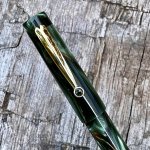PensFromNo11
Full Member
Continuing my kitless journey here are pen 2 and pen 3.
Pen 2 was not So good, I made the mistake of trying to add a clip and finials - for me this was a step to far and over complicated things so Ive decided to keep things as simple as possible for the next few pens.
Pen 3 was just a simple cap, body and section and overall it went ok.
In the cap I stepped the inside profile to keep some weight to it, but with this translucent material I’m not keen on the look.
I still have some work to do on the triple threads on both body and cap, they work ok, but I think the tenon on the body must of been a little out as its only catching on the last few threads (only half a turn to close - that wasn’t the design).
Happy with the overall look of cap and body, but the section shape defiantly not right yet. I nailed the threads for the nib and connection to the body, but the shape will need some work.
I only have a wood lathe, so any advice on getting the tenons square would be good or is it as I imagine just experience?
Pen 2 was not So good, I made the mistake of trying to add a clip and finials - for me this was a step to far and over complicated things so Ive decided to keep things as simple as possible for the next few pens.
Pen 3 was just a simple cap, body and section and overall it went ok.
In the cap I stepped the inside profile to keep some weight to it, but with this translucent material I’m not keen on the look.
I still have some work to do on the triple threads on both body and cap, they work ok, but I think the tenon on the body must of been a little out as its only catching on the last few threads (only half a turn to close - that wasn’t the design).
Happy with the overall look of cap and body, but the section shape defiantly not right yet. I nailed the threads for the nib and connection to the body, but the shape will need some work.
I only have a wood lathe, so any advice on getting the tenons square would be good or is it as I imagine just experience?











